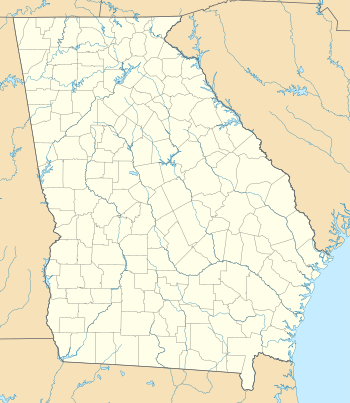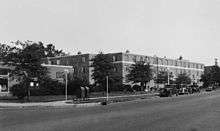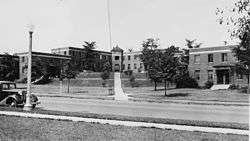Techwood Homes
|
Techwood Homes Historic District | |
|
Techwood Homes, late 1930s | |
   | |
| Location | Atlanta, Georgia |
|---|---|
| Coordinates | 33°46′4″N 84°23′30″W / 33.76778°N 84.39167°WCoordinates: 33°46′4″N 84°23′30″W / 33.76778°N 84.39167°W |
| Built | 1935 |
| Architect | Burge & Stevens; J.A. Jones & Co. |
| Architectural style | Colonial Revival, Other |
| NRHP Reference # | 76000632 |
| Added to NRHP | June 29, 1976[1] |


Techwood Homes was the first public housing project in the United States, opened just before the First Houses. Located in Atlanta, Georgia, it replaced a shantytown known as Tanyard Bottom or Tech Flats. It was completed on August 15, 1936,[2] but was dedicated on November 29 of the previous year by U.S. President Franklin D. Roosevelt. The apartments included bathtubs and electric ranges in each unit, 189 of which had garages.[3] Central laundry facilities, a kindergarten and a library were also provided. Techwood was intended to eliminate the slums that the poor had been living in, but eventually became one itself.
The complex was designed by Georgia Tech alumnus and architect Flippen David Burge (later Stevens & Wilkinson),[4] and organized by Charles Forrest Palmer, a real estate developer who had become an expert on public housing and would later head up both the newly created Atlanta Housing Authority and the Chamber of Commerce.[5] The landscaping was designed by Edith Henderson, who also designed the neighboring Clark Howell Homes with her partner Grace Campbell.[6][7]
The name came from Techwood Drive, in turn named for nearby Georgia Tech. The project included a 300-student dormitory for Georgia Tech, McDaniel Dormitory, commonly referred to as Techwood Dorm. It was run by the Atlanta Housing Authority. Throughout the 1970s, 1980s, and 1990s the area was synonymous with urban blight in Atlanta.
The neighboring Clark Howell Homes was built in 1941 in a less institutional style. A. Ten Eyck Brown was the architect. Clark Howell was reserved for whites only until 1968, with an all-black counterpart at the University Homes project (built 1938) near Atlanta University Center.[8]
Except for a few historic buildings, Techwood Homes was demolished in 1996 before the 1996 Summer Olympics. It and neighboring Clark Howell Homes are now a mixed-use area called Centennial Place.[2] The first phase opened in 1996 just before the Centennial Olympics, hence the new name. Former residents were relocated to other areas, and given Section 8 vouchers to pay part of the rent. Many moved back into Centennial Place, though it had far fewer subsidized units than Techwood Homes.[9]
See also
References
- ↑ National Park Service (2008-04-15). "National Register Information System". National Register of Historic Places. National Park Service.
- 1 2 "Techwood Homes". The Atlanta Housing Authority. Retrieved 2007-08-06.
- ↑ Sams, Gerald W. (ed): "AIA Guide to the Architecture of Atlanta", page 153. University of Georgia Press, 1993.
- ↑ McMath, Robert C.; Ronald H. Bayor; James E. Brittain; Lawrence Foster; August W. Giebelhaus; Germaine M. Reed. Engineering the New South: Georgia Tech 1885-1985. Athens, GA: University of Georgia Press.
- ↑ Biographical note, "Palmer, Charles F.", Emory Library EmoryFindingAid
- ↑ "Edith Henderson Papers". The Atlanta History Center website. Accessed Oct. 13, 2015.
- ↑ Catron, Staci L. "Biography of Edith Harrison Henderson". The Cultural Landscape Foundation website, August 11, 2015.
- ↑ Sams, page 154
- ↑ Portwood, Jerry (2002-02-06). "Techwood turnaround". Creative Loafing Atlanta. Creative Loafing Media. Retrieved 2007-12-01.
External links
- Techwood Homes New Georgia Encyclopedia
- Techwood history at artery.org
- Historic American Buildings Survey (HABS) No. GA-2257, "Techwood Homes (Public Housing), Bounded by North Avenue, Parker Street, William Street & Lovejoy Street, Atlanta, Fulton County, GA", 30 photos, 4 measured drawings, 46 data pages, 6 photo caption pages, and 24 other entries for individual structures such as:
- HABS No. GA-2257-C, "Techwood Homes, Building No. 1, 575-579 Techwood Drive, Atlanta, Fulton County, GA", 24 photos, 6 measured drawings, 13 data pages, 4 photo caption pages
- HABS No. GA-2309, "Clark Howell Homes (Public Housing), Bounded by North Avenue, Lovejoy Street, Mills Street & Luckie Street, Atlanta, Fulton County, GA", 54 photos, 28 data pages, 8 photo caption pages, and 13 other entries for individual structures such as:
- HABS No. GA-2309-B, "Clark Howell Homes, Anne Wallace Branch Carnegie Library, 538 Luckie Street, Atlanta, Fulton County, GA", 16 photos, 13 data pages, 3 photo caption pages

